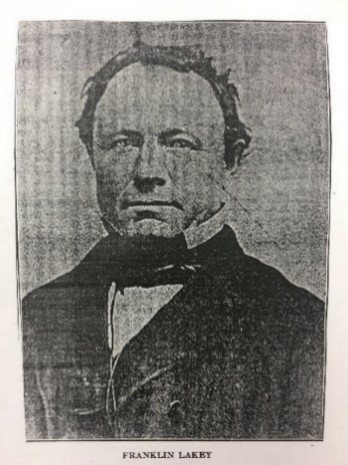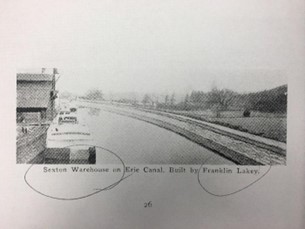
Franklin Lakey, son of Abner Lakey, was married to the daughter of Durfee Chase, the brother of Willard Chase. At age thirteen, Franklin was a friend of George Harris, the son of Martin and Lucy Harris.
Franklin went on to become a successful businessman in Palmyra, “distributing $100,000 a month” through his various businesses in the Palmyra community.[1] He built a distillery on Quaker Road about four rods west of Maple Avenue. In the distillery, he had 400 bushels of corn and barley ground up daily from which whiskey was extracted. He also ran two cooper shops to make heavy barrels for transporting his whiskey. “He was one of the large operators in grain and other produce in Wayne County, New York, and with his energy and genius for affairs, he was a recognized factor in the business world.”[2] He had the largest slaughter house in Palmyra. He hired hundreds of men. One of his employees was William Henry Huxley, who was sent by Franklin to Ithaca for a boat load of coal. He made the round trip from Palmyra to Ithaca in four days, the fastest time ever made.[3]
Franklin also owned an icehouse and a malt house. He bought everything offered from a muskrat skin to a load of wheat. The Wayne County Journal printed on June 10, 1875 that Franklin liked to decorate his fences with pelts of sheep he had slaughtered for their hides and tallow alone.[4] The Sexton Warehouse located near the Erie Canal was built by Franklin.[5]

In 1850, Franklin was listed in the US Federal Census as having a real wealth of $17,000.
On November 28, 1852, Tirza Lakey, wife of Franklin, died. She had been sick for several months with consumption and died suddenly with a hemorrhage. Her funeral was held at the Zion Episcopal Church in Palmyra.[6]
The 1860 US Federal Census listed Franklin as having a real wealth of $32,500 and a personal wealth of $50,000. During the 1860s, Franklin was the director of the Palmyra Railroad Line.[7] In 1870, Franklin was listed in the US Federal Census as being a grain and coal dealer. On March 21, 1872, George Washington Cuyler and Franklin Lakey were chosen as directors of the newly organized Canandaigua and Railroad Company.[8]
On June 4, 1875, Franklin died in Palmyra at age sixty.[9] It was said of his death:
Franklin Lakey was one of the most influential citizens in town. He was a very extensive produce dealer. . . . Unfortunately, when Franklin died a good deal of the Palmyra business died with him. The once thriving village of Palmyra that had commanded practically all the trade from the Erie Canal north to the lake, became a quiet little village.”[10]
On June 10, 1875, the Wayne County Journal printed.
The day before Franklin died, he was going about his usual business and was apparently in better health than he had been for weeks past. At 10 o’clock, he was struck with apoplexy from which he died the following morning. An hour after he died, “wheat went down five cents a bushel.” His funeral was held at the Zion Episcopal Church in Palmyra. Long before the appointed hour, the church was filled to capacity while hundreds waited outside who failed to gain admission. Services were conducted by Reverend Mr. Webster and closing remarks [were given] by Reverend Dr. Eaton. The largest train of mourners ever seen in Palmyra followed his casket to the grave. Businessmen from all parts of the state were in attendance.[11]
On August 2, 1875, Louis Lakey and Ira Lakey were appointed administrators of his estate. They were responsible for the goods, chattels, and credits of Franklin Lakey.[12]
[1] Cook, Palmyra and Vicinity, pp. 50–51; Porter, Backman, and Black, Regional Studies in LDS Church History: New York, p. 5.
[2] Pomeroy Developments in America, p. 65; Wayne County, New York Sightings, p. 6.
[3] Carolyn P. Jordon, Descendants of Thomas Huxley.
[4] Cook, Palmyra and Vicinity, p. 50–51; Porter, Backman, and Black, Regional Studies in LDS Church History: New York, p. 5.
[5] Joseph Smith Home Page, Wayne County.
[6] Durfee Scrapbook No. 1, 1831–1863; Palmyra Cemetery Record, Part 5.
[7] Annual Report on the Railroads of the State of New York, p. 425.
[8] “Palmyra Affairs,” Newark Courier, March 21, 1872.
[9] Palmyra Village Cemetery Update, p. 4.
[10] “Sudden Deaths at Palmyra,” Democrat and Chronicle [Rochester, NY], June 5, 1875.
[11] Durfee Scrapbook No. 2, 1864–1875.
[12] New York Wills and Probate Records (1659–1999).
